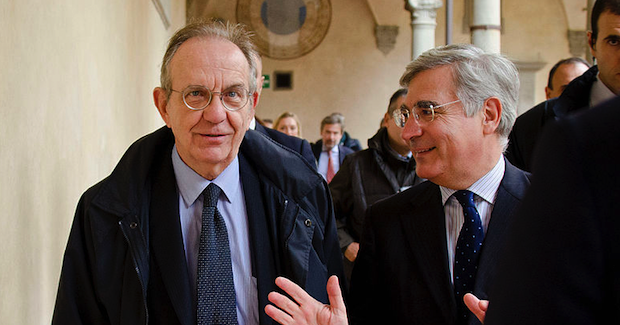Saving the Euro While Rebooting Italian Economy

Under the guidance of Finance Minister Pier Carlo Padoan, Italy has arguably been the only government battling against Germany for the recalibration of the Eurozone towards growth and shared prosperity. Many Italians blame the European Unions’s fiscal rules and austerity measures for a chronically stagnant economy; Padoan’s strongly critical rhetoric makes those concerns known to the Eurogroup.
Under Padoan’s watch, Italy emerged from a record-long double-dip recession. According to the latest OECD data, the economy will grow by 0.9 per cent in 2017 and 1.0 per cent in 2018. The budget deficit has declined to 2.4 per cent of GDP in 2016 from 2.6 per cent in 2015—the government was targeting 2.0 per cent but had to add spending worth 0.4 per cent of GDP for extraordinary measures to tackle earthquake reconstruction in central Italy and the migrant crisis. Padoan—a former official at the IMF and former chief-economist of the OECD—has made a 2017 budget that will appropriately support growth and consequently, further fiscal easing is assumed in 2018.I
t is vital that both the Italian population and the decision makers in Brussels—and Germany—follow Padoan’s lead.
The challenges ahead are well known: productivity performance, which has been rather poor since the early 1990s; debt-to-GDP ratio, which was at 1.33:1 for 2016; and Italy’s bad loan burden of €360 billion (AU$511 billion), which reflects its non-performing economy. In late December, the government asked parliament to increase the public borrowing limit by as much as €20 billion to ensure liquidity and reinforce capital for Italian banks. The government-backed recapitalisation would be conditional on the willingness of banks to put forth restructuring plans allowing them “to travel on their own legs, be profitable, and finance the economy”, per Padoan. The government will attempt to limit the fallout of the burden sharing, seeking to iron out with Brussels details of a compensation plan for as many as 40,000 retail bondholders.
Italy’s political instability won’t help in tackling these issues. Unfortunately, this is not something new. Renzi was Italy’s third unelected premier in a row—his predecessors being Mario Monti and Enrico Letta. With Italian voters rejecting the constitutional reform, Renzi resigned as he mistakenly promised to do. To replace Renzi, Italian President Sergio Mattarrella appointed previous foreign affairs minister and Renzi loyalist, Paolo Gentiloni—already under pressure from opposition parties, particularly the anti-establishment and anti-EU Five Star Movement.
The Eurozone is set on a path to self-destruction unless there is a recalibration. European Central Bank’s Mario Draghi has warned European leaders that the combination of rising global interest rates and explosive politics could expose Europe’s underlying weaknesses, even if there are signs of a moderate recovery. Draghi himself has been keeping the Euro’s hopes alive throughout the recent years by overcoming and outmanoeuvring the current German conservatism and dogmatism. The immediate solution for the Eurozone is a shift away from the politics of austerity.
In its most recent economic outlook, the OECD made a plea for growth-inducing fiscal expansion. Germany’s surplus is above the allowed thresholds and the rules must be symmetrical, both the deficit and the surplus must be adjusted. If the Eurozone continues to fail to deliver widely shared prosperity, it will be vulnerable to political and economic shocks. Generating economic divergence among members rather than convergence is the true issue at hand for Eurozone leaders.
The risk of disintegration is such that the EU needs to send a strong and clear message of reform and unity. Risk-sharing is a fundamental component to a successful Eurozone, especially in economic times where some countries are under tight fiscal constraints. Padoan has proposed a European finance minister and financial integration through the banking union and capital markets union. This European finance minister would manage common resources to ensure financial stability and would coordinate economic policies to avoid imbalances among members.
The Italian government’s work has allowed the country to encourage the EU to focus its economic strategy more on investment and growth. As Padoan stated, “the EU is the only road possible but it must change, Italy has done many things to change the EU agenda with this government and the results can be seen.” It breathes new life into the ideals of the EU, especially after Brexit. Padoan’s vocal stance on European matters and his strategy of setting an agenda of growth and shared prosperity should be applauded in difficult times that have bred nationalism and protectionism. The worrying factor is that this Italian government might be the last hope for setting and delivering the growth-enhancing agenda needed to secure Italy’s long-term future in the Eurozone.
Pedro Sousa is a Portuguese political economist who has worked at the OECD and the UN. His work is related to macroeconomics and politics as a writer, researcher, and strategic adviser.
This article is published under a Creative Commons Licence and may be republished with attribution.





